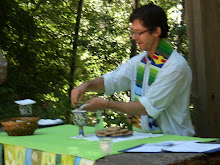This is part two of an article that appeared in the newsletter of St. John's, Petaluma in August and September of 2013.
In 2007 the continuing St. John’s Episcopal congregation
made the fateful decision to pursue the recovery of the historic parish
property. This decision was more than a
claim to the right of inheritance of a legacy from the past. It was also a claim on the future. It was a declaration that this group of
people aspired to a prominent and lasting presence in the social landscape of
Petaluma, a presence symbolized by these buildings at the corner of Fifth and
C.
| Ernest Coxhead, Architect (1863-1933). |
In the years since retaking possession of this property, we
have been learning anew what that prominent and lasting presence implies. Even when we are embroiled in the immediate
challenges of meeting our present needs, the intention to be here for a long
time shapes the way we go about doing what we do. When the vestry approves an enabling
resolution, an investment policy, and other policies for a parish endowment, as
it did in July, it says that we have a long-term investment in this place, and
we encourage our members to see St. John’s as part of the legacy of their lives
to the generations to come. When we put
resources into redecorating our nursery, or developing our Godly Play Sunday
school, or sponsoring the Petaluma Children’s Chorus, we are saying that St.
John’s is a place not just for today, but for tomorrow.
But this commitment to the future is not just a matter of
how we attend to our own affairs. If our
mission were simply to win as many individual souls for Christ as possible before
God’s imminent destruction of the world, we wouldn’t care much what our
neighbors were up to. But I believe that
Christian eschatology (a fancy academic word that means “words about the last
things”) is better understood as radical
hope for what Christ’s love can do in and with this good old world. And this kind of hope requires us to act as
thoughtful citizens of a larger community.
If we really intend to be here for a long time, we are going to need an
economically vibrant, socially-just, and ecologically sustainable town to
sustain us, and that is not something we can achieve by ourselves.
But neither can we be assured that it will happen without
us. And God has given us a particular
gift, a charism, to give to the
shared enterprise of making a durable future for Petaluma. Coming to understand what that gift is,
valuing it, claiming it, and learning to give it, is the real work of our
process of congregational renewal. Our
beautiful Episcopal tradition gives us deep springs to drink from, and the
rootedness of timeless forms. This gives
us a firm place to stand when engaging in conversation about what values,
practices, images, and stories ought to shape the future of our town. At the same time, our stable forms are the
vessel for a dynamic, fearless, boundary-crossing Spirit that urges us into these
conversations, not just as people with testimony to give, but as those who seek
to be converted. Against every urge to
grasp onto the past, or retreat from the unknown and unfamiliar, the
irresistible imperative of the Gospel keeps sending us forward to meet the
future. The mission of Jesus keeps
impelling us outward to seek and find and know all the places where God’s dream
is coming true.
Our unique and beautiful church building is a symbol, in
wood and glass and stone, of aspiring to be grounded in tradition, and at the
same time creatively attuned to the emerging possibility. Ernest Coxhead, the architect of St. John’s,
received the finest schooling, in France and England, in the classical
disciplines of his trade. But a restless
search for something new sent him to America.
He spent a few years on the East Coast, where the Gothic revival in
church architecture was in full swing, but finally found his way to California,
where Bishop Kip put him to work designing Episcopal Churches. What Coxhead gradually developed was a style
that suited this strange new land on the far edge of the world. In buildings like St. John’s he playfully
combined elements of Gothic, Romanesque, Classical, and Queen Anne styles in a
way that evoked the past but did not attempt to imitate it. He put in a curved apse wall like in a Roman
basilica, but he put it at the wrong end of the church.
It’s weird, but somehow it works. It feels timeless, but it’s actually daringly
new. When we reclaimed this property in
2009 we didn’t just get an old building.
We inherited the spirit that inhabits it, a spirit of appreciation for
the past and enthusiasm for the future, of commitment to the whole and
inventiveness with respect to the parts, of determination to make something beautiful,
and the willingness to risk being absurd.
This spirit, not always an easy one to discern or to follow, has from
time to time led this congregation down some strange paths, and into blind
alleys. But the lessons of those
mistakes are part of our inheritance. In
any case, it is our gift, and it is a legacy we can build on.

No comments:
Post a Comment